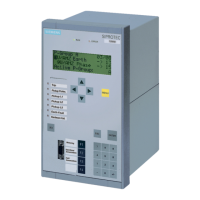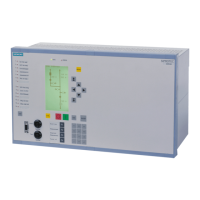•
Is the reference voltage V
1
above the setting value Vmin, but below the maximum voltage Vmax?
•
Is the voltage V
2
to be synchronized above the setting value Vmin, but below the maximum voltage
Vmax?
•
Is the voltage difference V
2
– V
1
within the permitted threshold dV ASYN V2>V1?
•
Is the voltage difference V
1
– V
2
within the permitted threshold dV ASYN V2<V1?
•
Are the two frequencies f
1
and f
2
within the permitted operating range f
Nom
± 3 Hz?
•
Is the frequency difference f
2
– f
1
within the permitted threshold df ASYN f2>f1?
•
Is the frequency difference f
1
– f
2
within the permitted threshold df ASYN f2<f1?
When the check has been terminated successfully, the device determines the next instant at which the two
systems are in phase from the angle difference and the frequency difference. The ON command is issued at
this instant minus the operating time of the circuit breaker.
De-energized Switching
Connecting two components of a power system is also possible if at least one of the components is de-ener-
gized and if the measured voltage is greater than the threshold 6106 V>, with a multiple-phase connection at
side V
1
all three voltages must have a higher value than threshold V> so that side V
1
is recognized as ener-
gized. With single-phase connection, of course, only one voltage has to exceed the threshold value.
Besides release under synchronous conditions, the following additional release conditions can be selected for
the check:
SYNC V1>V2<
= Release on the condition that component V
1
is energized and component V
2
is de-ener-
gized.
SYNC V1<V2> = Release on the condition that component V
1
is de-energized and component V
2
is ener-
gized.
SYNC V1<V2< = Release on the condition that component V
1
and component V
2
are de-energized.
Each of these conditions can be enabled or disabled individually; combinations are thus also possible (e.g.,
release if SYNC V1>V2< or SYNC V1<V2> are fulfilled).
For that reason synchronization with the use of the additional parameter 6x13 25 Synchron (configured to
NO) can also be used for the connection of a ground electrode. In such a case, one may only connect when
there is no voltage on the load side, i.e. under synchronous conditions no connection is permitted.
The release conditions can be configured individually either for automatic reclosing or for manual closing via
control commands. You can, for example, allow manual closing for synchronism or for de-energized feeder
whereas before an automatic reclosing operation, checking only de-energized conditions at one feeder
terminal and afterwards only synchronism at the other.
The threshold below which a power system component is considered as de-energized is defined by parameter
V<. If the measured voltage exceeds the threshold V>, a power system component is energized. Thus, with a
multiple-phase connection at side V
1
all three voltages must have a higher value than threshold V> so that
side V
1
is recognized as energized. With single-phase connection only one voltage has to exceed the threshold
value.
Before granting a release for connecting the energized component V
1
and the de-energized component V
2
,
the following conditions are checked:
•
Is the reference voltage V
1
above the setting value Vmin and V>, but below the maximum voltage Vmax?
•
Is the voltage to be synchronized V
2
below the thresholdV<?
•
Is the frequency f
1
within the permitted operating range f
Nom
± 3 Hz?
After successful termination of the check the release is granted.
2.21.1.4
Functions
2.21 Synchronization Function
294 SIPROTEC 4, 7SJ62/64, Manual
C53000-G1140-C207-8, Edition 08.2016

